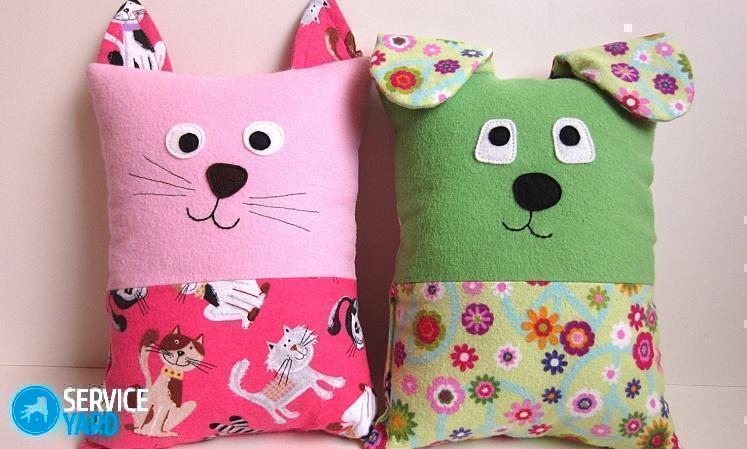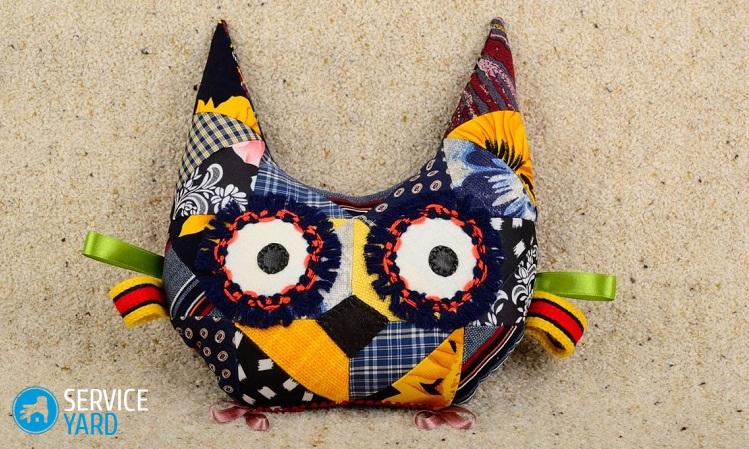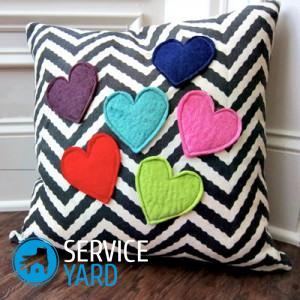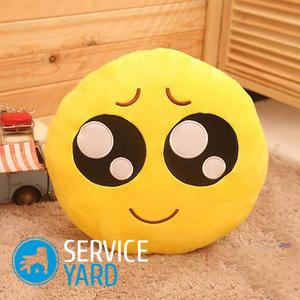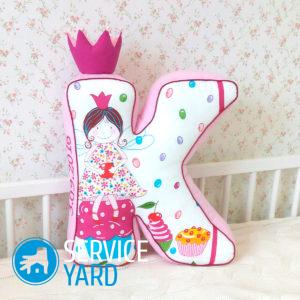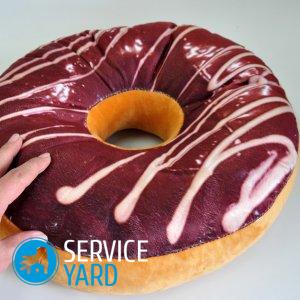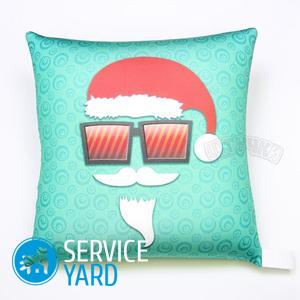DIY Pillows
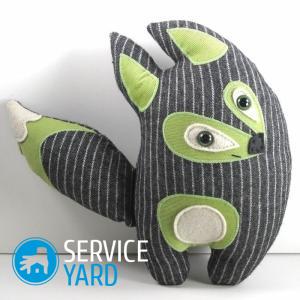
The invariable attribute of a bedroom is a pillow. A correctly selected version of such a product contributes to quality sleep and pleasant dreams. The modern market presents a huge assortment of various models, among which are pillows and toys. In this article we will look at how to make DIY pillows.
to contents ↑What is the difference between a toy pillow?
Such products are made in the form of a soft toy, mainly some kind of animal. Children with such a pillow are very interested in playing, you can sit on it, if necessary - lie on the floor, take it with you during sleep. Such a pillow can successfully emphasize and enliven an interior made in a certain style.
Important! Pillows toys do not require a large amount of material, they can be made with your own hands from the remains of wool or unused scraps. For children, such creativity also plays a developing role - with a variety of shades, a child can learn the names of colors. So, for example, a product made in the form of a house with windows or a typewriter helps the kid learn not only the names of the colors, but also get acquainted with geometric shapes.
The process of making a pillow toy is quite simple. To do this, you can draw a pattern yourself or use the ideas of home needlewomen, which can be found on the Internet.
to contents ↑Important! When choosing material for a toy, it should be remembered that the fabric should not cause allergies and shedding.
Choosing an idea for a pillow
The shape of the future pillow toy with your own hands depends on its purpose:
- Pillow roller. To implement this idea, you can make a pillow in the form of a snake, a dachshund dog or a train.
- Pillow on the road. For this purpose, you need to choose a semicircular shape, thanks to which the product can be put under the neck of the baby.
- If the soft product is intended for sleeping, then you do not need to use strongly protruding, hard eyes and nose. Such a pillow does not allow you to snuggle up against it in order to fall asleep. In this case, it is preferable to make a toy from a soft flannel or fleece.
- Manufacturers produce a separate category of cushioned pillows, the use of which contributes to the rapid falling asleep of the baby.
- In order to sit comfortably on a pillow, they give it a flat shape.
- If the baby likes to read or play while lying on the floor, then the soft product needs to be made large.
- The long version of the pillow is suitable for window sills and doors from drafts.
Materials and Tools
To sew any version of a pillow toy with your own hands, you must first prepare the following materials:
- appropriate fabric;
- internal packing;
- thread with a needle;
- decoration elements;
- sewing machine;
- chalk for cutting or a simple pencil to transfer the pattern to the fabric;
- scissors;
- paper to build patterns.
Fabrics
An important element when sewing a decorative pillow is fabric. When choosing a material, you need to turn on the imagination, paying attention to the texture and coloring of the fabric.
Modern industry presents a wide range of fabrics, from which we can distinguish the most commonly used for sewing decorative soft products:
- flock and fleece;
- cotton and linen;
- upholstery material;
- knitwear;
- felt;
- velor and plush;
- sackcloth;
- velvet and satin;
- jeans;
- natural and artificial fur;
- dermatin and skin.
Important! The most important criterion for choosing a fabric is ease of care.
Very often fabrics are combined, but in this case it is necessary to be guided by certain rules:
- you can not combine material that does not stretch with stretch fabric options;
- the fabric of the pillow may not be combined with the upholstery of the bed, sofa or armchairs - such an accessory may be an accent in the interior design;
- colors can be combined, for example, if the interior is mainly green, then yellow, blue or blue material is used to make a decorative pillow;
- when choosing fabric with a pattern, it is necessary to give preference to lively and laid-back patterns, decorated in the form of fruits or flowers;
- the cage material and plant motifs look good;
- fabrics of all colors of the rainbow, which depict drawings of favorite fairy-tale heroes, are suitable for the children's room;
- when choosing a material, it is necessary to take into account its purpose - for sleeping, a softer and more pleasant to the touch fabric is used, and for the decorative version of products, a denser material can be used;
- for a more relaxed interior, dark shades are chosen, the presence of light and brightly decorated pillows add vividness and energy to the atmosphere;
- if feathers or fluff is used for the filler, it is necessary to use a denser fabric capable of retaining the filler inside the product;
- when choosing fabric, it is preferable to choose universal cotton fabrics;
- silk material is characterized by a cool surface;
- brocade looks great when making decorative pillows in the bedroom.
Important! There is a long-known method for verifying the correct choice of fabric. In good light it is necessary to look closely at the material for 1 minute, and then close your eyes. If flashes or bright spots appear in front of the eyes, then this fabric is an unsuitable option.
Stuffing
When choosing fillers for a pillow toy with your own hands, you should adhere to some recommendations:
- stuffing material should keep its shape;
- only hypoallergenic fillers should be used;
- stuffing material should not be too hard, even and too soft;
- after washing, the filler must not change its properties.
Important! In the absence of filler, some needlewomen stuff the product with what is at hand. So, for example, if you use tissue residues as a filler, the product is not very neat.
All fillers that are used for decorative pillows are divided into the following types:
- natural materials;
- vegetable fillers;
- synthetic and artificial variety.
Natural
More recently, stuffing a pillow with natural materials, used feather, fluff, wool. The advantages of natural materials are:
- heat preservation;
- they do not go astray;
- do not crumple.
The disadvantages include:
- moisture absorption;
- favorable environment for the reproduction of bacteria and other animals;
- the occurrence of allergies.
Important! Such decorative pillows require special care for them.
Vegetable
Recently, decorative pillows began to fill with vegetable fillers, such as:
- medicinal herbs;
- hop cones;
- buckwheat husk;
- bamboo.
Many consumers are of the opinion that this type of stuffing has a beneficial effect on human health and well-being. But this is sometimes a false opinion. The smell of some herbs may cause a headache. In addition, the vegetable filler, having absorbed moisture, dampens, and then rots.
Important! For decorative pillows with vegetable fillers, frequent replacement of the packing and special care of the products are required.
Artificial and Synthetic
For artificial and synthetic packing of decorative pillows, the following materials are mainly used:
- synthetic winterizer;
- sintepuh;
- foam rubber;
- holofiber;
- materials from polyester.
Such materials are hypoallergenic, non-toxic and do not absorb moisture. The disadvantages include the fact that after some time such materials are caked and pressed.
Here's what to consider when choosing:
- It is best to use holofiber, which is soft to the touch and can easily machine wash.
- As a filler, a sintepuh or a firework can be a good option. Such materials are hypoallergenic, do not go astray, pillows with such fillers can easily restore their original appearance.
- Foam rubber can be used as a filler for cushion rolls.
Important! In addition to generally accepted materials, for stuffing decorative products, you can also apply:
- cotton, but this material very quickly gets off, loses its original shape, the product takes an unsightly appearance;
- fur - this material is suitable for filling decorative products made of durable, coarse fabrics;
- silicone balls, which are safe material suitable for stuffing baby pillows.
Thread
When choosing threads for sewing a pillow-toy with your own hands, it is important to consider not only quality, but also compatibility with fabrics. So, for denser fabrics, durable threads are used. During manufacture, floss threads are used, which are suitable for making decorative seams, or decorative brushes can be made from them.
When choosing a suitable thread option, you need to familiarize yourself with the classification of sewing threads:
- Cotton - are entirely made of cotton and are the most common type of thread used when sewing items made from cotton material.
Important! Cotton threads are not recommended for fabrics that stretch, since at the time of pulling, such threads can break.
- Polyester - are dense threads with a wax or silicone coating.
Important! Polyester threads are used when working with knitwear, synthetics, with stretch fabrics and stretch fabric.
- Viscose - embroidery thread, using which creates smooth stitches.
- Nylon - durable threads that are used when working with light and ordinary synthetic fabrics.
- Silk is a durable thread used for wool and silk. These threads are elastic and do not leave marks on the fabric.
- Woolen - used for embroidery, they can process the edges of products from heavy fabrics.
- The metal version is mainly found in golden, bronze or silver colors, such items are embroidered or decorated with products.
to contents ↑Important! When choosing a thread, you must adhere to some recommendations:
- the selected threads should correspond not only to the color scale of the fabric, but also be consistent with the thickness of the fabric used;
- if a sewing machine is used for sewing the product, then the upper and lower threads should be the same;
- the use of a thin thread on a dense fabric helps to interrupt the thread, and a thick version of a thread on a thin fabric will tighten the product, while the appearance of the finished object deteriorates;
- if there is no possibility to choose threads in the tone of the fabric, then you can pick up threads that are 1-2 tones darker than the material, so sewn stitches will not be so noticeable.
Monkey
Consider the process of a self-made children's pillow-toy in the shape of a monkey with your own hands. In order to sew with your own hands toys for children or an accessory on the sofa in the form of a monkey, you need to cut out the pattern, and then proceed according to the algorithm:
- We take the chocolate-colored satin material and cut out two pieces of the monkey's head from it.
- From the brown gabardine we cut out the monkey's face.
- Two blanks of the back of the ears are cut out of satin fabric, and the front parts of the ears are cut out of gabardine.
- We cut the cut blanks.
- Using white interlining, duplicate the details of the face of the monkey and ears.
- We sew the front back blanks of the ears, while leaving a small opening, then cut the edges with scissors.
- We turn out the details of the future toy, fill them and sew them up.
- We decorate the head of the monkey, sew the muzzle to the front side, and fix the ears with pins.
- We attach the back of the monkey’s head, flash it on a sewing machine, without forgetting to leave the hole for filling the muzzle unstitched.
- We turn the part on the front side, stuff it and sew it up.
- For the design of the eyes, we use two small circles, which we sew on the muzzle, and on top we sew black buttons.
- In order for the monkey to smile, you need to embroider the nostrils of the nose with black threads and make a smile.
- Applying woolen threads, we supplement the pillow-toy with a forelock, and the original product in the shape of a monkey is ready.
Elephant
The pink elephant is a little girl's dream. Toy store cushions do not always have an attractive look. A self-made elephant will bring joy to your baby.
Consider the process of making a pillow toy elephant do it yourself:
- Draw or print an elephant template of the appropriate size.
- We circle it on a fleece fabric folded in half, not forgetting to add a few centimeters for the seam allowances.
- We cut the blanks and sew them together, while leaving a gap for stuffing.
- We turn the part on the front side.
- The future elephant is stuffed with a filler.
- Exactly the same principle sew ears and tail.
- Sew all the details to the body.
- We make a pillow with eyes.
- From the blue fabric we cut a small oval.
- We attach the cloud to the body.
Unusual elephant pillow is ready!
to contents ↑Turtle
A pillow toy in the form of a turtle is able to decorate not only the child’s room, but can also fit perfectly into the gazebo located in the garden. For the manufacture of toys you will need colored shreds of fabric suitable for the color scheme.
Consider the process of making a pillow-toy turtle with your own hands:
- We cut out the base of a round shape for the belly of the animal, the dimensions of which depend on the scale of the future product.
- We cut out four triangles of different colors, slightly round the edges of the blanks.
Important! When folding these blanks together, you should get a circle corresponding to the diameter of the abdomen.
- We prepare two parts of the head, two tails and eight blanks of the legs.
- We flash all the elements in pairs, leaving a gap.
- We twist the details and stuff them with a synthetic winterizer.
- We sew colored flaps in pairs, attaching the blanks of the head and tail.
- Sew the stomach and back of the animal, while distributing the details of the legs.
- We turn the base on the front side and fill it with filler.
- Sew eyes and mouth.
The pillow toy in the form of a turtle is ready!
to contents ↑Owl
Young children are sometimes naughty at bedtime when they are sent to sleep. A self-made pillow toy in the form of a spy-owl helps the baby fall asleep much faster.
Consider the process of making a soft owl pillow with your own hands:
- We take a sheet of paper that matches the size of the future pillow-toy.
- On it we draw a sketch of an owl, cut out a template.
- We transfer it to felt material, draw a pattern.
- Cut out the eyes and beak of the future owl.
- We glue the cut parts onto a double-sided adhesive base, iron it with an iron.
- We impose the details on the body of the future product, sew a zigzag seam.
- We stuff the finished pillow-toy with filler.
Hug cat
Young children love to sleep hugging with their favorite toy. A hugging toy can be made in the form of your favorite pet - a cat.
Consider the process of making a cat-hugging pillow pillow with your own hands:
- We prepare two patterns for the head, torso and legs of the cat.
- Having folded the synthetic winterizer several times, we make out the detail of the nose.
- With the help of a French knot, we make eyes.
- On the duplicate fabric, transfer the sketch of the head.
- We embroider the cat’s mouth and mustache with zigzag thick threads.
- Sew on the nose, it is advisable to pre-glue it in several places.
- Sew eyes and ears in the same way.
- Sew parts of the head from the wrong side, while leaving a gap.
- We turn the part on the front side and stuff it with filler.
- Sew the paws and tail of the animal.
- Separately, we make a round or rectangular pillow.
- We stuff it with a synthetic winterizer.
- Sew all parts of the animal to the pillow.
to contents ↑Important! If you add a bow tie, you get a nice cat, and if you attach a bow to your head, then the hug will be in the role of a cute cat.
Stock footage
It is difficult to imagine a plain, inexpressive version of a pillow-toy for young children. Homemade needlewomen try to give brightness to such products, decorating them in the form of cartoon characters and animals. For this, the craftswomen use all kinds of materials and tools, only you need to first determine the purpose of the manufactured product. As a decor, use colorful ribbons, bows, buttons, shoelaces, lace, zippers, beads or beads. If the pillow is designed for the smallest children, then the product should not have small accessories in order to protect the child from swallowing small elements. Yes, and for older children, it is desirable to sew all the additional accessories well and glue them, thus extending the life of a funny animal!



